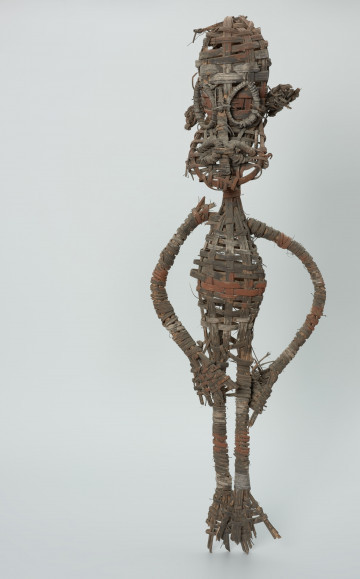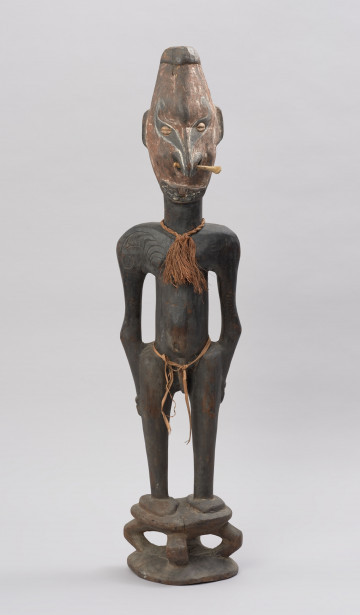
Doll representing ancestor
1951 — 1995
National Museum in Szczecin
Part of the collection: Art of Papua New Guinea
The sculpture depicts an ancestor in the form of the kokomo bird, the carnivorous hornbill (Rhyticeros plicatus), also known as the Papuan hornbill. It was carved in the Sepik River basin of Papua New Guinea in the Central Sepik region. Concerning the large head, which is considered a symbol of spiritual strength in Papuan culture, the rest of the figure's body appears frail. Papuans living in New Guinea for generations lived in small and isolated villages. They waged constant wars and explained their sudden death and illness by interfering with a sorcerer from the enemy village. In this dangerous world, a crucial role was attributed to the ancestors, held in high esteem and reverence. The cult of ancestors originates from the belief that the dead do not go away forever, but stay close to their community, providing it with knowledge and support. According to Papuans, death releases the knowledge, power and strength located in the deceased's head. These beliefs were reflected in art. Sculptures depicting ancestors often have disproportionately large heads to the rest of the body, which usually appears frail, rearranged in a very schematic way, serving primarily to mark sexual features and the pattern of scarification. The power stored in the heads of the ancestors was supposed to ensure the prosperity and success of the entire village, while the tangible proximity of the ancestors gave people a sense of confidence, the assurance that they were not alone and vulnerable in the face of the dangers that life brings. The Middle Sepik artists are considered masters in the use of colour. They use a wide range of colours, the most popular being black, white, brown and red. Apart from the dominant colours, shades of yellow, grey and beige can also be found. The paint was obtained by mixing natural pigment with palm oil and Sepik clay. The addition of blood provided the brownish-red colour. The colour was not only used to decorate the sculpture but it was also intended to encourage the ancestor to inhabit the figure.
Katarzyna Findlik-Gawron
Author / creator
Dimensions
cały obiekt: height: 71 cm, width: 17,9 cm
Object type
sculpture
Creation time / dating
Creation / finding place
Identification number
Location / status

1951 — 1995
National Museum in Szczecin

1951 — 2000
National Museum in Szczecin

1970
National Museum in Szczecin
DISCOVER this TOPIC
Castle Museum in Łańcut
DISCOVER this PATH
Educational path